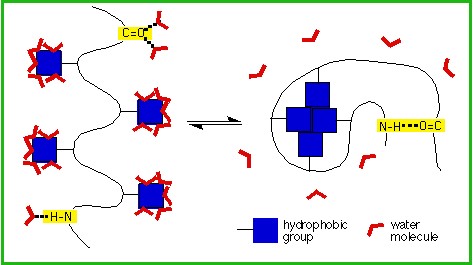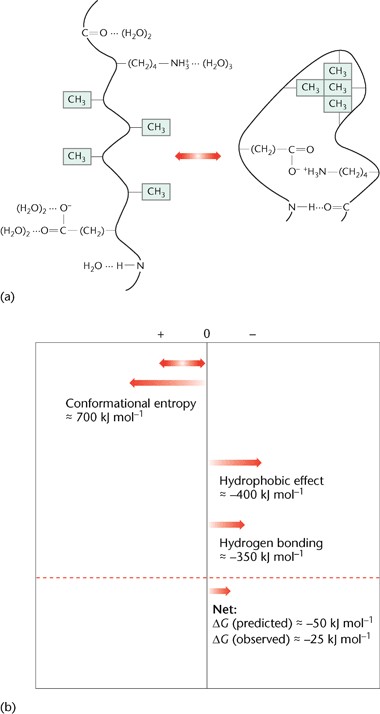Characterizing biopharmaceutical protein stability is critical during all phases of biopharmaceutical development, including candidate selection, preformulation screening and formulation development, process development, and manufacturing support. Protein stability and higher order structure is also used to assist with biocomparability studies. Profacgen provides protein stability analysis technologies for the biopharmaceutical industry.
There are three major factors affecting protein stability: hydrophobic interactions, hydrogen bonds and conformational entropy. The literature is in general agreement that the two types of interaction that are most prevalent in proteins are (i) hydrophobic interactions and (ii) hydrogen bonds. The reaction of these bonds upon going from the unfolded to the folded state is summarized in the figure below.

Figure 1. Diagram showing the burial of hydrophobic moities and formation of intramolecular H-bonds upon protein folding. Note the release of water molecules upon folding.
Profacgen has excellent technical knowledge and long-standing experience in performing stability studies for biopharmaceutical products, such as proteins. Typical studies performed are:
| Accelerated stability studies | |
| Degradation testing | |
| Stress testing | |
| Short and long-term testing | |
| Orthogonal stability indicating techniques |

Figure 2. (a) Scheme illustrating the formation of an intramolecular hydrogen bond, a hydrophobic bond and an ion pair in the folding of a protein. (b) Contributions to the free energy of folding of ribonuclease Sa at 25 °C and pH 7. Ribonuclease Sa contains 96 amino acids. The values for the conformational entropy, hydrophobic effect and hydrogen bonding are taken from experimental studies. Contributions from ion pair formation are relatively small and not shown in this figure.
The stability analysis services of protein we can offer include, but not limited to:
| pH stability assessment | |
| Thermal stability assessment | |
| Aggregation analysis | |
| The measurement of in vitro serum stability | |
| The assessment of in vivo plasma stability |
By leveraging advanced technologies and extensive experience, Profacgen has come to the unique position not only owning the instrument and expertise necessary for the comprehensive assessment of your protein, but also the capability to provide these analytical services in the most cost and time efficient manner.
Fill out this form and one of our experts will respond to you within one business day.